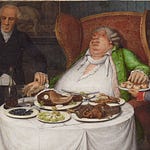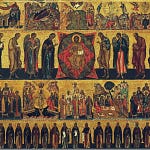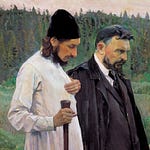The Studite Typikon is a compilation of rules as they were observed in the Studite Monastery - the Monastery of Saint John the Baptist in Studios (outside of Constantinople) - in the 9th century. It originated from a synthesis of the Typikon of Saint Sabbas with the Cathedral Office used in only two churches - Saint Sophia in Constantinople (the Great Church) and Saint Demetrios in Thessalonica.
This Studite Typikon was the one used initially by monasteries and churches in the lands of the Rus. For example, when Saint Theodosius of the Kiev Caves set out to organize a coenobium near Kiev in the 11th century, he received a copy of the Studite Typikon from Constantinople, which the Kiev Caves monastery used for a few hundred years. Eventually, the Russian Church adopted the Typikon of Saint Sabbas, which it continues to use today with some changes and developments.
Because both the Studite Typikon and that of Saint Sabbas were close, there existed greater uniformity in the order of services between Churches of the Greek and Russian traditions. In the 19th century, the Cathedral Office was revised for parish use in Greek churches, which marked a formal divergence between Greek and Slavic liturgical practices. According to Metropolitan Kallistos (Ware), the new edition of the Cathedral Office formalized abbreviations and omissions which had already become widespread in Greek parishes. Our interest in the Studite Typikon, however, lies not with the order of services but with the rules for fasting.
It is important to note that both the Studite Typikon and that of Saint Sabbas were developed by and for monks. Saint Sabbas the Sanctified was a monk who lived in the 5th and 6th centuries, as was Saint Theodore the Studite who lived three hundred years later. Their aim was to regularize the lives of their respective monasteries; and neither appeared to be much interested in how 21st-century Americans living in California or New York ought to fast or pray. Nonetheless, parish clergy and Orthodox lay people have usually gravitated toward these monastic rules as guides for organizing their own ascetic discipline, prayer rules, and liturgical practices.
Listen to this episode with a 7-day free trial
Subscribe to Phroneo to listen to this post and get 7 days of free access to the full post archives.












